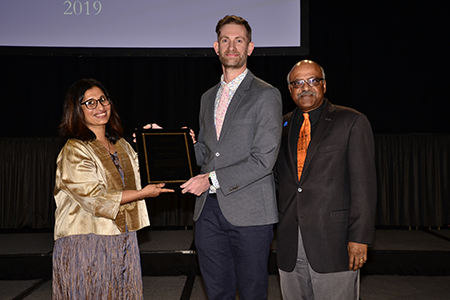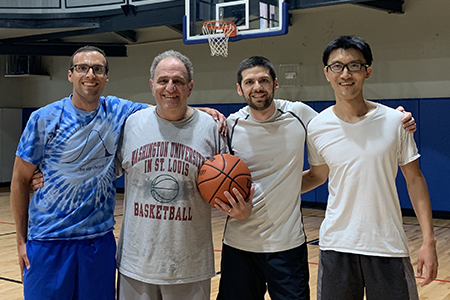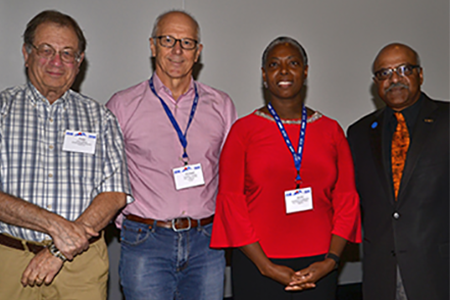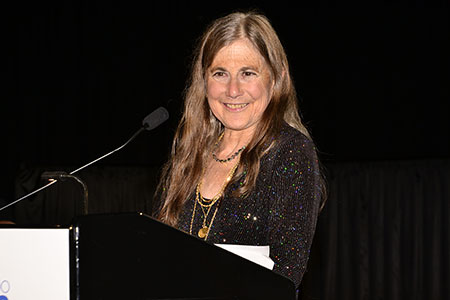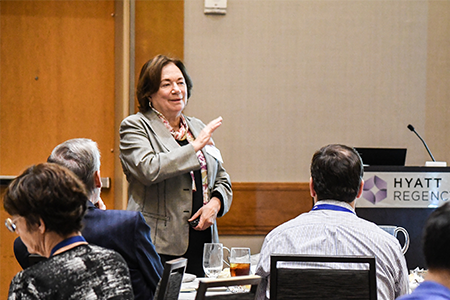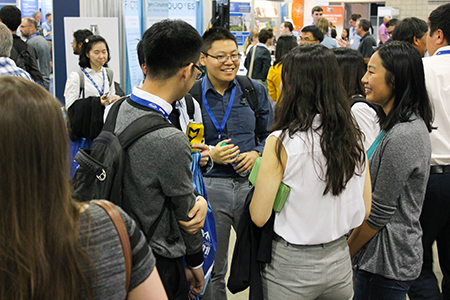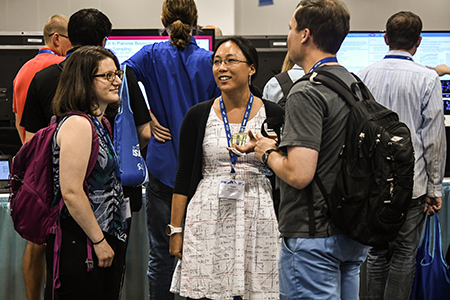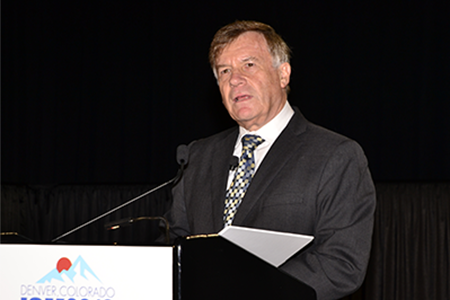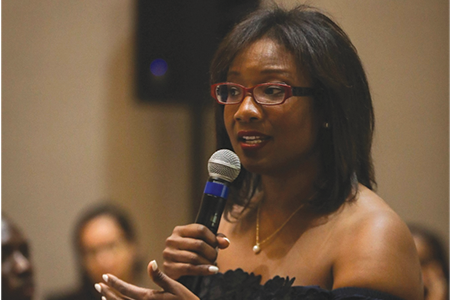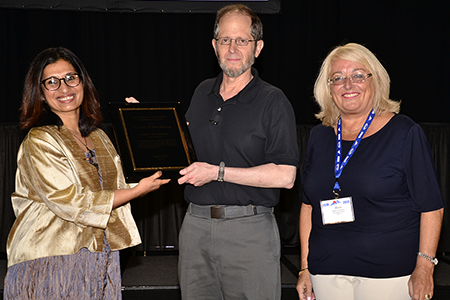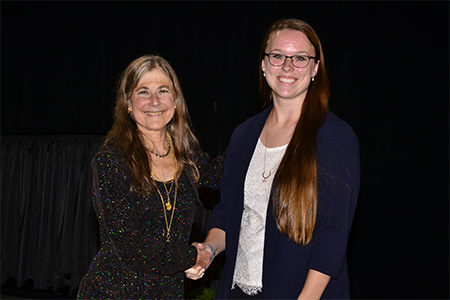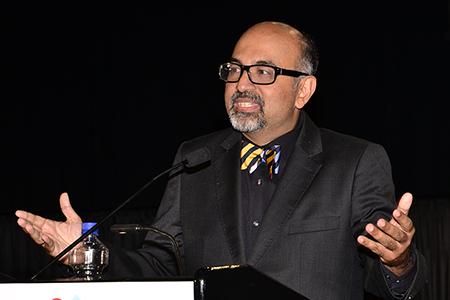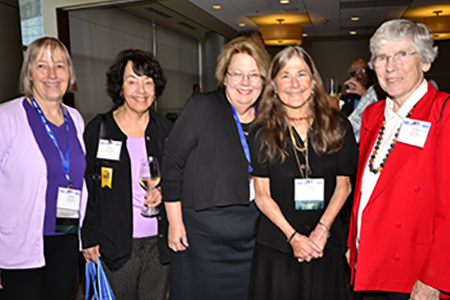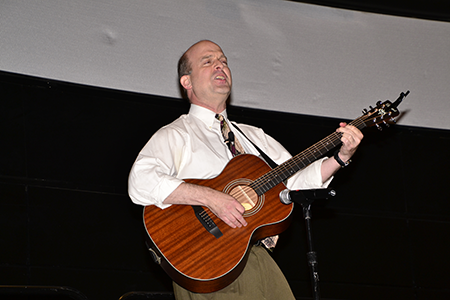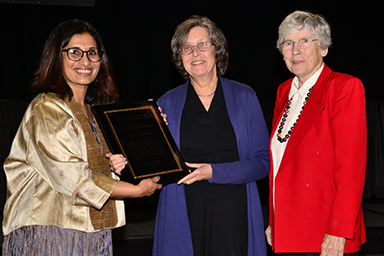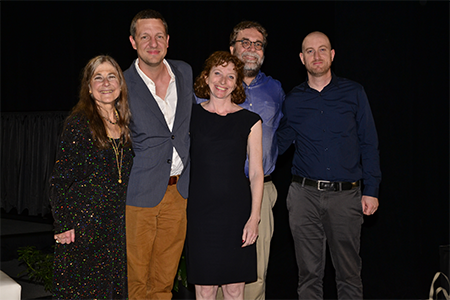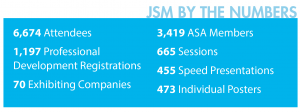JSM 2019: Reminiscing on the Impact
Rich Levine, JSM 2019 Program Chair
Let us reflect on yet another successful JSM, set against a backdrop of the awe-inspiring Colorado Front Range. I will remember fondly riding the free mall shuttle up and down 16th Street, reveling in the JSM downtown signposts welcoming us to Denver, connecting with statistical colleagues lounging for a coffee break at the Hyatt, and being greeted by the big blue bear wanting to get in on our festivities. We for sure fulfilled ASA President Karen Kafadar’s theme of Statistics: Making an Impact at the foothills of the Rockies!
The meetings got off to a smashing start with a jam-packed Sunday schedule. Nothing like starting the conference with your ABCs and CSI (the statistics version), featuring introductory overview lectures (IOLs) by Christian Robert on approximate Bayesian computation and Hal Stern on forensic statistics. The IOLs prepared attendees for more technical talks on these themes later in the week.
The second annual JSM Public Lecture was scheduled on Sunday evening to attract more local interest. That time slot was a huge success, as a standing-room-only audience enjoyed Mark Glickman’s talk, “Data Tripper: Distinguishing Authorship of Beatles Songs Through Data Science.” Glickman illustrated musical feature selection on his guitar as he quantified the probability that either Paul McCartney or John Lennon wrote certain Beatles songs. Eighth-grader Ray Levine shared his intrigue with the musical riffs to illustrate data science concepts. And 10th-grader Katherine Wang, an accomplished pianist and saxophonist, opined on the interweaving of machine learning and music theory, excited by the data science prospects.
Many Honored at Presidential Address and Awards Ceremony
Diversity Workshop and Mentoring Program Celebrates 10 Years
Hadley Wickham Wins Prestigious COPSS Presidents’ Award
Statistics Workshops for Math and Science Teachers Held in Denver
2019 Beyond AP Statistics (BAPS) Workshop Attracts a Dozen Teachers
The first day concluded with the traditional kick-off Opening Mixer, at which attendees took in the invited poster session, Data Art Show, and exhibit hall booths and snacks. The electronic posters featured themes this year: geophysical modeling, learning analytics, medical imaging/neurosciences, object-oriented data analysis, and uncertainty quantification.
Though a late first night, the excitement continued through the week for the 6,674 JSM attendees. Of particular note, JSM 2019 upped a number of records set at JSM 2018: number of abstracts, number of speed presentations, and number of posters. The latter two records are not surprising, given my “soap box invitation” toward this direction in a November 2018 Amstat News piece. I was excited to see not only the growing popularity of speed and poster sessions, but also the intense discussions and energy between speakers and individuals at the many poster sessions I attended.
Plenary Talks and Lectures
JSM 2019 featured talks and discussions on a wide range of statistical and data science topics of the day, including big data surveys, data science education, deep learning, reproducible research, statistical communication and collaboration, uncertainty quantification and visualization, and analyses of microbiome data and real-world data/electronic health records. And, of course, we had talks and discussions about the imminent Census 2020! The slides from many talks may be viewed via the online program. Let us highlight the plenary talks and lectures that played out through JSM week.
Following are the four plenary talks:
- ASA President’s Address and Awards, Karen Kafadar, “Reinforcing the Impact of Statistics on Society”
- ASA President’s Invited Address, Teresa Sullivan, “Coming to Our Census: How Social Statistics Underpin Our Democracy (and Republic)”
- Deming Lecture, Nicholas Fisher, “Walking with Giants: A Research Odyssey”
- COPSS Awards and Fisher Lecture, Paul Rosenbaum, “An Observational Study Used to Illustrate Methodology for Such Studies”
Additionally, JSM featured a number of named lectures (in alphabetical order):
- Florence Nightingale David Lecture, Susan Ellenberg, “Statisticians and the Evolution of the Randomized Clinical Trial”
- IMS Presidential Address and Awards, Xiao-Li Meng, “011, 010111, and 011111100100”
- Yee Whye Teh, “On Statistical Thinking in Deep Learning”
- David Dunson, “Learning and Exploiting Low-Dimensional Structure in High-Dimensional Data”
- Helen Zhang, “Breaking the Curse of Dimensionality in Nonparametrics”
- Elizaveta Levina, “Hierarchical Communities in Networks: Theory and Practice”
- Matthew Reimherr, “Challenges in Privacy with Functional Data”
- Michael Kosorok, “Some Recent Developments in Precision Medicine”
- Rietz Lecture, Yoav Benjamini, “Selective Inference: The Silent Killer of Replicability”
- Sirken Lecture, Judith Lessler, “Is Survey Research a Fact-Based Endeavor?”
- Wald Lectures, Trevor Hastie, “Statistical Learning with Sparsity”
- Michael Lavine reintroduced the likelihood principle in “Assessing Procedures vs. Assessing Evidence,” his perspective in this post p<0.05 era.
- Jennifer Hill and Ari Rosen presented “Causal Inference in Modern Statistics,” a reoccurring topic each day of JSM given the advent of personalized medicine, electronic medical records, and big data in observational studies.
- Walt Piegorsch and David Banks presented “Modern Risk Analysis,” hitting the modern data-analytic settings of environmental risk and adversarial risk.
- Hollylynne Lee, William Finzer, and Beth Chance presented “Pedagogy and Technology for Teaching Statistics,” which was moderated by Allan Rossman and addressed students’ statistics education needs for succeeding in this data-rich information age.
Medallion Lectures:
- Noether Lectures:
The goal of the IOLs, as the name suggests, is to introduce JSM attendees to state-of-the-art areas in statistics. We mentioned two IOLs earlier, though all six were aimed at introducing popular subjects seen throughout the JSM program. In order of offering at JSM were the following:
We had a unique late-breaking session this year organized by Xuming He. A panel including Bin Yu, David Banks, David Madigan, Dylan Small, Marianthi Markatou, and Michael Jordan discussed the findings from an NSF-sponsored workshop and project in “Statistics at a Crossroads: Who Is for the Challenge?” The panelists shared their perspectives on a vision for statistics in the next decade of this data science era while Nandini Kannan moderated.
Every year, memorial sessions honor recently deceased statisticians who had a major impact on our field. This year, we remembered and celebrated the lives of Larry Brown as organized by Tony Cai and Linda Zhao, Jayanta Ghosh as organized by Subhashis Ghoshal, Susanne Rassler as organized by Florian Meinfelder, Tom Short as organized by Allan Rossman, Herb Spirer as organized by Megan Price, and Joan Staniswallis as organized by Ori Rosen. The JSM program also featured sessions discussing the statistical legacy of David Blackwell, organized by Sastry Pantula, to celebrate Blackwell’s 100th birthday; Larry Brown, organized by Chaitra Nagaraja, on his contributions to graduate student education; Florence Nightingale David, organized by Amanda Golbeck, as part of the new COPSS award; and W. Edwards Deming, organized by Joyce Orsini.
An Invitation
I will close by inviting you to get involved with JSM in any capacity you can. The experience is rewarding and the relationships you develop—I will predict with confidence—are rich and long lasting. I look forward to contributing to JSM 2020 and seeing everyone in the City of Brotherly Love next August!

